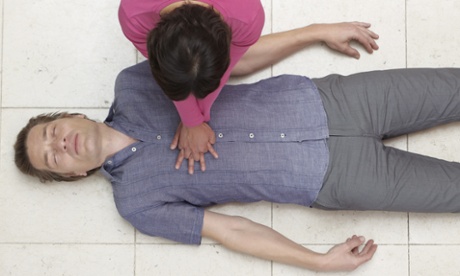
Locking lips with a stranger at death’s door may not be on your to-do list. But new research in the Journal of the American Medicinal Assocation (Jama) shows that anyone who has a cardiac arrest has a better chance of survival if a bystander immediately tries to resuscitate them. The good news is that the mouth-to-mouth bit of CPR (cardiopulmonary resuscitation) is no longer essential – you can save a life by performing chest compressions that push blood round the body again.
Inconveniently, most people’s hearts don’t wait to get into hospital before they arrest. While bystanders wait for someone to shout, “Let me through I’m a doctor!”, the person’s chances of survival fall by 10% a minute. The British Heart Foundation says that only one in 10 people who have a cardiac arrest outside hospital will survive. Those who do make it risk brain injury through oxygen deprivation.
The solution
The Jama study included data over four years from 4,961 cardiac arrests in 11 North Carolina counties. During this time, each county ran a campaign encouraging people to perform chest compressions or use automated external defibrillators while waiting for an ambulance. Survival with good brain function increased overall by 37%. The proportion of patients who got CPR (chest compressions) from bystanders increased from 39.3% to 49.4%. About 11% of people who got CPR from bystanders survived without serious brain damage compared with 8% who had to wait for someone trained to arrive. Another study in this week’s Jama of CPR in Japan also found that chest compressions on their own carried out by a willing bystander increased survival. The researchers found that family members were less likely than strangers to have a go at CPR. It may be even harder to respond calmly and quickly to a loved one in distress – but when someone is in cardiac arrest they are virtually dead. So what is there to lose?
So, of course everyone should learn CPR. If an adult is unresponsive without a pulse, then pressing on their chest is better than doing nothing at all. If they shout “Get off!”, just say sorry and stop. The simple CPR version used by both the British Heart Foundation and American Heart Association says you should phone an ambulance and then press hard and fast in the centre of the chest without stopping– 100 times per minute to the beat of Stayin’ Alive by the Bee Gees until a paramedic or ambulance arrives. In the US, cardiac arrests are particularly common at racetracks, casinos and business places. In Britain, rates are highest in airports and railway stations. So start practicing now.

